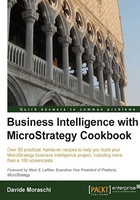
Introduction
At this point, you should have a testing machine ready-to-use with all the samples in place. In the previous chapter, we have learned how to install SQL Server and the MicroStrategy platform. In this chapter, we start creating the schema objects that represent the building blocks of our BI project.
Schema objects are the metadata components that are logically closer to the physical structure of the database; they are used to create more complex elements (applications or public objects) that will later form reports and documents. Facts and tables, for example, are schema objects. Also attributes, which we'll cover in Chapter 3, Schema Objects – Attributes, are schema objects.
The first schema objects that we need to identify are the tables holding our facts and dimensions.
Note
We will use the sample database AdventureWorks, which is about a sport gear shop. The size of the data is limited but the overall structure of the tables is quite interesting and covers a number of use cases that you will find in real-life BI projects. All the recipes in this book use that database.
To get acquainted with the tables and their relationships, please download this diagram with the full database schema at http://at5.us/Ch2U1. Due to its size, it would be useful to print it out on A3 size paper.
The schema is quite complete and contains information about primary and foreign keys. I wish all of my jobs would start with a clear picture like this…
Tip
Downloading the example code
You can download the example code files for all Packt books you have purchased from your account at http://www.packtpub.com. If you purchased this book elsewhere, you can visit http://www.packtpub.com/support and register to have the files e-mailed directly to you.